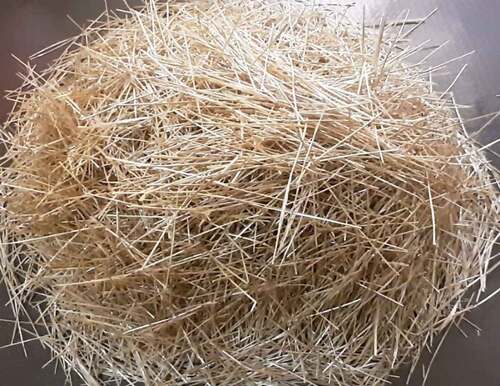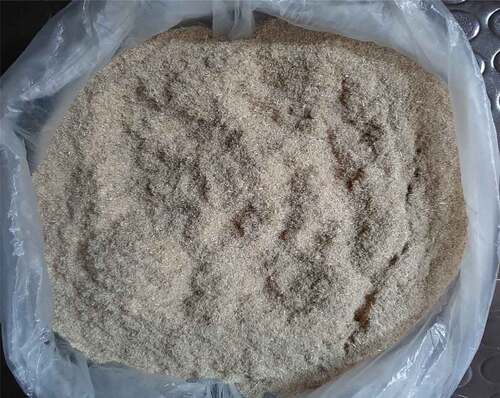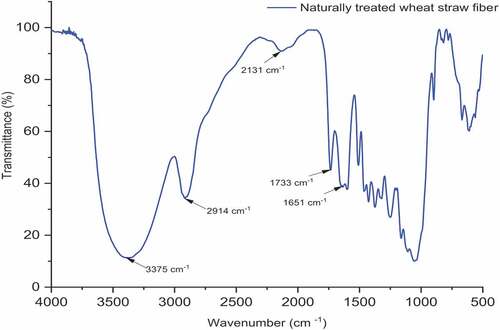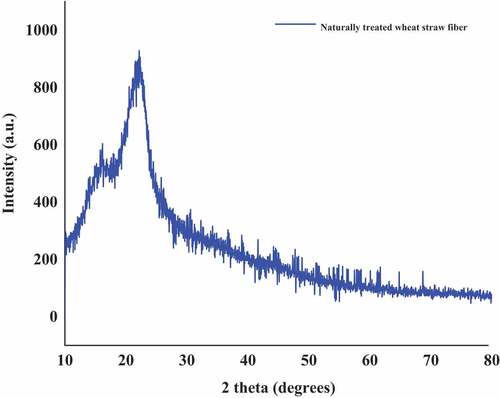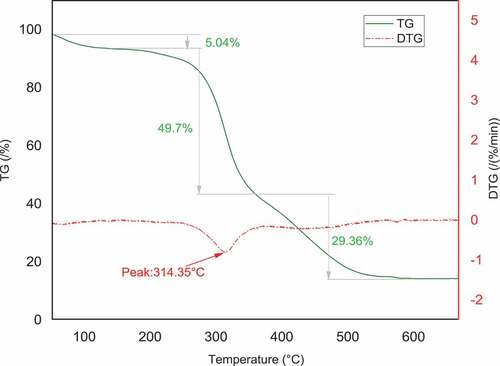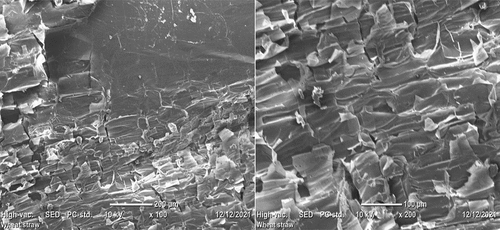 ?Mathematical formulae have been encoded as MathML and are displayed in this HTML version using MathJax in order to improve their display. Uncheck the box to turn MathJax off. This feature requires Javascript. Click on a formula to zoom.
?Mathematical formulae have been encoded as MathML and are displayed in this HTML version using MathJax in order to improve their display. Uncheck the box to turn MathJax off. This feature requires Javascript. Click on a formula to zoom.ABSTRACT
This specific study investigates the chemical and morphological properties of naturally treated wheat straw fiber growing around in Jimma zone. The chemical composition properties including cellulose 45.43%, hemicellulose 36.50%, and lignin 21.61% were determined. The physical properties of naturally treated wheat straw fibers, such as bulk density, particle density, moisture content, and ash content, are 0.037 g/cm3, 0.194 g/cm3, 10.04%, and 1.44%, respectively. The chemical functional group of naturally treated wheat straw fiber was established by Fourier transform infrared spectroscopy (FTIR), crystallinity index is calculated by X-ray powder diffraction (×RD) analysis, and the thermogravimetric analysis (TGA) result ensures that the naturally treated wheat straw has thermally withstood up to 314.35°C. A fiber’s surface morphology shows the presence of shallow pores, which increase the surface roughness of the fiber; this contributes to increased contact surface area, which ensures better fiber-matrix adherence in composite fabrication. We conclude that naturally treated wheat straw fiber has a significant value in fiber reinforced concrete technology as reinforcement materials in concrete composites formation by incorporating optimum percentage to reduce the limitation of concrete and to enhance the mechanical properties of concrete.
摘要
这项具体研究调查了吉马地区周围生长的天然处理麦草纤维的化学和形态特性. 测定了纤维素45.43%、半纤维素36.50%和木质素21.61%的化学组成特性. 经天然处理的麦草纤维的体积密度、颗粒密度、含水量和灰分等物理性能分别为0.037 g/cm3、0.194 g/cm3,10.04%和1.44%. 通过傅里叶变换红外光谱(FTIR)确定了天然处理麦草纤维的化学官能团,通过X射线粉末衍射(XRD)分析计算了结晶度指数,热重分析(TGA)结果确保了天然处理的麦草纤维具有高达314.35°C的热耐受性. 纤维的表面形态表明存在浅孔,这增加了纤维的表面粗糙度; 这有助于增加接触表面积,从而确保在复合材料制造中更好地粘附纤维基体. 由此可见,天然处理的麦秸纤维在纤维混凝土技术中作为混凝土复合材料形成的增强材料具有重要的价值,可以通过加入最佳比例来降低混凝土的局限性,提高混凝土的力学性能.
Introduction
Wheat straw is one of the by-products of agricultural residuals which was generated during the harvest of crops. It’s an annually renewable fiber resource that is available in abundant or a lot of quantity in many regions of the world. Wheat cultivation area is the world’s largest agricultural land covered among the cereal crop production, wheat being the most prolific and most widely distributed food crop than other. At present, the global sum of the wheat plant areas is more than 2.2 million hectares with an annual wheat grain output of 730 million tons, accounting for one-third of the world’s total food production. From the production point of view, the world’s largest wheat-producing country is China followed by India, the United States, and Russia, and these four countries produce 45% of the total world wheat production. With this, there are more than 650 million tons of wheat straws available annually (Fang and Shen Citation2018). Wheat is a cereal crop, which is produced in most parts of Ethiopia. Ethiopia is second next to Egypt in Africa, in wheat production, which is 4.54 million tons in 2016 (Abate Citation2018). Wheat straw is the product of the wheat crop and is usually available in surplus to requirements in many countries. Over the last few decades, the production, availability, and utilization of natural fibers increased worldwide by showing physical properties are determined by various researchers in their study of work which shows the potential of the fibers to be used as construction material. The natural fibers that are used in applications of civil engineering include coir, sisal, sugarcane, bamboo, jute, palm, hemp, pineapple leaf, hair, and wheat straw. The utilization of natural fibers can lead to sustainable development. In agrarian countries, natural fibers are cheap and locally available which have very less economic use. Hence, its use as a construction material costs very little, in fact almost nothing when compared with the total cost of composite. In this way, huge savings can be made by using natural fibers. Fibers are frequently used in the concrete to resist the cracking due to the early age shrinkage and drying shrinkage (Ahmed, Farooqi, and Ali Citation2020; Geremew et al. Citation2021). Therefore, due to its cheap availability and easy access, the use of wheat straw in civil engineering applications can be effective (Capital University of Science and Technology – Islamabad, Pakistan et al. Citation2016; Chen et al. Citation2018; Farooqi and Ali Citation2016; Huang et al. Citation2015; Maria and Manea Citation2015). The typical features of wheat straw fiber are light bulk density, a short generation cycle, economic and environmental building materials (Huang et al. Citation2015). Also, wheat straw fiber is an agricultural waste material obtained anywhere in the garden of the cultivated area of a wheat cereal crop, due to these farmers around this area utilizing an open-field burning the excess amounts of wheat straw is common practice for straws disposal and continuously burned year after year without utilizing for an application, thus creating environmental issues such as spreading of uncontrolled fire to nearby forest and disordering of the ecosystem of the environment. Currently, research in composite materials is being initiated directly by using natural fibers instead of synthetic fibers. The use of natural fibers, derived from annually renewable natural resources, as reinforcing fibers in matrix provides a positive environmental benefit with respect to ultimate disposable and raw material utilization. There are various areas of application of natural fibers in composite materials industrials level rapidly increases the attention of researchers in worldwide due the increasing environmental awareness, its renewable, sustainable, abundant, and CO2 neutral alternative to fossil feedstock for a portfolio of fuels, chemicals and materials (Bernardo, Gírio, and Łukasik Citation2019; Manzanares Citation2020; Morais et al. Citation2016; Morone and Yilan Citation2020). But, the concept of using fibers to improve the characteristics of construction materials is very old techniques, such as a soil reinforcement for adobe brick manufacturing and other engineering application by incorporating with short, discrete, arbitrarily oriented fibers during the preparation stage to enhance the mechanical property composite materials, in order to reduce cracks and shrinkage due to volumetric variation (Islam, Islam, and Hasan Citation2022; Sanjay et al. Citation2016; Singh Dhaliwal Citation2020). One of the typically used reinforcing material was an agricultural waste by products utilized in various civil engineering application. Straw is the by-product and a waste of the wheat crop. Straw is getting the attention of researchers and its use as reinforcement in composites is increasing nowadays. But there is a need to explore the straw for applications as well. Therefore, based on the above advantage of utilizing wheat straw for the application, it is better to understand some of the physical properties, chemical compositions, and morphological properties of wheat straw fibers. Likewise, some researchers studied such areas (Cai et al. Citation2017; Chen et al. Citation2018; Kasmani and Samariha Citation2011; Liu, Yu, and Huang Citation2005). The main objective of this study was the preparation and characterization of wheat straw grown around Jimma zone, Ethiopia, for application of concrete technology for improving the mechanical property of concrete composite materials, in order to reduce cracks and shrinkage due to volumetric variation by incorporating this naturally treated wheat straw fiber. Based on the above advantages of natural fibers, the detailed exploration of the preparation and characterization of this naturally treated wheat straw fiber was investigated before utilization of composite in concrete application technology which should be studied because it affects the property of fresh and hardened concrete during a composite formation. Therefore, this study initiates other researchers, specifically natural fiber reinforced concrete technology to help their detailed study to start from the fiber preparation stage, overall processing and its characterization analysis should be included before further application to be utilized in fiber reinforced concrete composite formation.
Materials and methods
Preparation of wheat straws fiber
To achieve this objective, the research followed an experimental type of study which begins by using purposive sampling techniques which is a Non-probability method that was adopted to collect samples from a nearby source. Locally available wheat straws were dipped in portable water for 15 to 20 minutes. The purpose of dipping was to remove the dust or impurities from the surface of the straw until the color of the water was clear. After that, the straws were air-dried. These prepared straws are named naturally treated wheat straws fiber as shown in .
Procedure determining the chemical composition of wheat straw fiber
The prepared naturally treated wheat straws fiber shown in are allowed to be sundried and ground by a Wiley mill to form powder as illustrated by , then finally the sieving process is carried out. Based on this procedure screened wheat straw powder passed through the number 40-mesh sieve but retained on the number 60-mesh sieve was taken for chemical analysis (Aklilu Citation2020). The chemical characterization of wheat straw fiber was conducted based on the standard procedure as shown in .
Table 1. Standards procedure used to determine a chemical characterization of wheat straw fiber.
Fourier transforms infrared (FTIR) analysis
The FTIR spectroscopy aids in determining the presence of specific functional groups that existed in natural fiber to ensure the presence of chemical composition (Hyness et al. Citation2018). The FTIR absorption spectrum was performed using a single beam Fourier transform infrared spectrometer; Nicolet 6700FTIR spectrometer, available in Material Science and Engineering, Jimma University. The naturally treated wheat straw fiber was initially prepared in the form of powder and then potassium bromide (KBr) pellets are required for the preparation of test samples before the analysis. Approximately 2 mg of wheat straw fiber powder sample were mixed with pelletized with Potassium bromide (KBr), blended it until a uniform color was visible, and then by carefully placed in FTIR sample holder to be analyzed for the test.
X-ray diffraction (×RD) analysis
The X-ray Diffractometer apparatus was used to predict the crystallinity index (CrI) value of the prepared naturally treated wheat straw fiber (powdered samples) for further investigation. Based on this analysis the crystallinity index indicates the degree of crystalline nature of fiber used with its detailed information on crystal lattice arrangements. This test was conducted at Jimma University Institute of Technology; Laboratory of Materials Science and Engineering with its required instrumental specification procedures; DW-XRD-Y7000 (Shanghai) instrument was used with its scanned rate with 0.03° s−1 and its data are recorded in the range of 2θ = 10° to 70° running on Cu Kα radiation beam operated at 30kv and 25 mA at 25°C. To determine the crystallinity index (CrI) from its peaks obtained from estimated by using the OriginLab was used to analyze and fit the peak observed during analysis.
Thermogravimetric analysis (TGA)
One of the main importance of examining natural fiber by thermogravimetric analysis (TGA) supports to distinct the thermal stability opportunity to distinguish their appropriateness for various applications at higher temperature situations and also it’s derivative thermogravimetric (DTG) curve shows the significant stage at which the degradation occurred in terms of weight loss in the nitrogen atmosphere (Geremew et al. Citation2021). This test requires about 8 mg powdered wheat straw fiber which was prepared based on Aklilu (Citation2020) which was measured and then placed in a sample holder to be inserted into a TGA balance. The experiment was conducted in the presence of nitrogen (N2) gas with a ml per minute and the sample heating temperature was increased from 30°C to 1000°C at a rate of 30°C/min.
Scanning electron microscopy (SEM)
The analysis of the surface morphology helps to understand the nature of the fiber surface using the scanning electron microscopy (SEM) instrument. From these SEM results, it can easily realize the distribution of various constituents existing on the entire fiber surface and the other advantage of SEM is to measure the average diameter of fiber with high magnification resolution (Geremew et al. Citation2021). The uniform and non-uniform distribution of reinforcement particles are verified by using SEM analysis.
Results and discussion
The physical property of wheat straw fiber
The detailed physical properties of the wheat straw fiber used in this experimental investigation are illustrated in . The moisture content of the wheat straw fiber was determined based on ASTM D 2495, 2001 standard specification to estimate the amount of moisture content in the wheat straw.
Table 2. Property of wheat straw fiber.
Chemical composition of wheat straw fiber
The chemical analysis of the main component of wheat straw fiber is listed in . Among the components, cellulose is the main reinforcement material and stability to the plant cell walls in the fibers (Geremew et al. Citation2021) and is held together by an amorphous hemicellulose section. The amount of cellulose content in wheat straw was comparable with an experimental study conducted with that of the previous studies (Kasmani and Samariha Citation2011).
Table 3. Chemical composition of wheat straw fiber.
FTIR analysis
The result of the analysis is plotted between the wavenumber and the normalized transmission carried by a frequency wave with critical peaks (Hyness et al. Citation2018). Based on , the analysis of the result indicated that there is a large band observed at 3375 cm−1, which is mainly related to the hydroxyl groups and the bound O-H stretching vibration present in carbohydrates (Cellulose + hemicellulose). The band at 2914 cm−1 represents the C – H stretching vibration. In addition, the absorption band at 2131 cm−1 was assigned to C≡C stretching. A strong absorbance band which is in the 1650–1750 cm−1 region indicates that a carbonyl group (C=O) is present. You will notice in that a region with a lower frequency 400–1400 cm−1 in the IR spectrum is characteristic of the compound as a whole found in most materials.
XRD analysis
The X-ray diffraction pattern of the naturally treated wheat straw fiber it’s the high-intensity peak located at 22.08° as shown in ; it shows the crystalline nature of the materials used and its intensity value shows the amount of crystalline structure in the naturally treated wheat straw fiber. Therefore, the crystallinity index (CrI) is calculated by EquationEquation (1)(1)
(1) . Based on this, the crystallinity index was estimated as 61.38% which is comparable with pervious study (Jiang et al. Citation2020; Sain and Alemdar Citation2006) and this shows some inherent properties of cellulose materials occurring in naturally treated wheat straw fibers.
Thermal analysis
Based on ; the thermal degradation behavior of naturally treated wheat straw was considered by using TG and DTG curves. It is clearly shown that the thermal degradation of naturally treated wheat straw happened in three phases. The first weight loss existed between 54.95°C and 153.24°C, which was due to the moisture disappearance of the fiber, and its corresponding weight loss at this stage was approximately 5.04%. The second main degradation developed from 153.24°C to 361.64°C was mainly caused by the decomposition of the cellulose fiber by 47.9% of a major mass loss was detected and a noticeable a peak was observed at this stage; this was approved by presenting at the first derivative weight lost which is found at 314.35°C which was in the range of the second degradation level. In the last stage; due to the difficulty of decomposing lignin, the decomposition of non-cellulosic materials such as lignin occurred at a lower decomposition rate and over a wider temperature range, from 361.64°C to 590.44°C mass losses in this interval an approximately 29.36%.
Surface morphology analysis
A fiber’s surface morphology is a critical factor in determining the fiber’s ability to act as good reinforcement and resist fiber pullout. SEM images show the presence of shallow pores, which increase the surface roughness of the fiber (). Surface roughness contributes to increased contact surface area, which ensures better fiber-matrix adherence in composite manufacturing. This roughness facilitates adhesion between other ingredients of in concrete composite materials during production stage. Beyond this it helps to improve the mechanical properties of concrete composite materials, and also to reduce crack formation and shrinkage due to volumetric variation.
Conclusions
In this study, the chemical and morphological properties of wheat straw fiber growing around in Jimma zone were investigated. Based on this, the chemical composition analysis properties show the amount of cellulose 45.43%, hemicellulose 36.50%, and lignin 21.61% were determined based on standard procedures. The physical properties of wheat straw fibers such as Bulk density, Particle density, Moisture content, and ash content are 0.037 g/cm3, 0.194 g/cm3, 10.04%, 1.44% are respectively. FTIR analysis of the results indicated that there is a large band observed at 3375 cm−1, which is mainly related to the hydroxyl groups and the bound O-H stretching vibration present in carbohydrates (Cellulose + hemicellulose). The band at 2914 cm−1 represents the C – H stretching vibration. In addition, the absorption band at 2131 cm−1 was assigned to C≡C stretching. A strong absorbance band which is in the 1650–1750 cm−1 region indicates that a carbonyl group (C=O) is presented. Its crystallinity index (CrI) was 61.38% shows some inherent properties of cellulose materials in naturally treated wheat straw fibers. The thermogravimetric analysis result ensures that the naturally treated wheat straw fiber can thermally withstand up to 314.35°C. The fiber surface morphology shows the presence of shallow pores, which increase the surface roughness of the fiber; this contributes to increased contact surface area, which ensures better fiber-matrix adherence in composite fabrication. Finally, based on these analysis results, it has a significant value in fiber reinforced concrete technology as reinforcement materials in concrete composites formation by incorporating optimum percentage to reduce limitation of concrete and to enhance mechanical property of concrete.
Highlights
• The Chemical properties of wheat straw including cellulose 45.43%, hemicellulose 36.50%, and lignin 21.61% were determined.
• The physical property of wheat straw fibers such as Bulk density, Particle density, Moisture content, and ash content are 0.037 g/cm3, 0.194 g/cm3, 10.04%, 1.44%, respectively.
• FTIR analysis of the result indicated that there is a large band observed at 3375 cm-1, which is the hydroxyl groups and the bound O-H stretching vibration existing in carbohydrates (Cellulose + hemicellulose).
• The thermogravimetric analysis result ensures that the naturally treated wheat straw has thermally withstood up to 314.35°C.
• A fiber’s surface morphology shows the presence of shallow pores, which increase the surface roughness of the fiber; this contributes to increased contact surface area, which ensures better fiber-matrix adherence in composite fabrication.
Disclosure statement
No potential conflict of interest was reported by the author(s).
Additional information
Funding
References
- Abate, D. 2018. Review on market chain analysis of wheat in Ethiopia. The International Journal of Business Management and Technology. 2 (94–105):12.
- Ahmed, T., M. U. Farooqi, and M. Ali. 2020. Compressive behavior of rice straw-reinforced concrete for rigid pavements. IOP Conference Series: Materials Science and Engineering 770 (1):012004. doi:10.1088/1757-899X/770/1/012004.
- Aklilu, E. G. 2020. Optimization and modeling of ethanol–alkali pulping process of bamboo (Yushania Alpina) by response surface methodology. Wood Science and Technology 54 (5):1319–10. doi:10.1007/s00226-020-01188-z.
- Bernardo, J., F. Gírio, and R. Łukasik. 2019. The effect of the chemical character of ionic liquids on biomass pre-treatment and posterior enzymatic hydrolysis. Molecules 24 (4):808. doi:10.3390/molecules24040808.
- Cai, J.-W., Z. Li, S.-J. Yan, and J. Li. 2017. Effect of straw fiber content on properties of cement-based composite. DEStech Transactions on Engineering and Technology Research 961–66. doi:10.12783/dtetr/apetc2017/11109.
- Capital University of Science and Technology – Islamabad, Pakistan, Muhammad Usman Farooqi, Majid Ali, and Capital University of Science and Technology – Islamabad, Pakistan. 2016. Compressive behavior of wheat straw reinforced concrete for pavement applications. 707–16. doi: 10.18552/2016/SCMT4S231.
- Chen, J., E. Mohamed, A. Elbashiry, T. Yu, Y. Ren, Z. Guo, and S. Liu. 2018. Research progress of wheat straw and rice straw cement-based building materials in China. Magazine of Concrete Research 70 (2):84–95. doi:10.1680/jmacr.17.00064.
- El-Abbassi, F. E., M. Assarar, R. Ayad, A. Bourmaud, and C. Baley. 2020. A review on alfa fibre (Stipa Tenacissima L.): From the plant architecture to the reinforcement of polymer composites. Composites: Part A, Applied Science and Manufacturing 128 (January):105677. doi:10.1016/j.compositesa.2019.105677.
- El-Fattah, A. A., A. G. M. EL Demerdash, W. A. Alim Sadik, and A. Bedir. 2015. The effect of sugarcane bagasse fiber on the properties of recycled high density polyethylene. Journal of Composite Materials 49 (26):3251–62. doi:10.1177/0021998314561484.
- Fang, G., and K. Shen. 2018. Wheat straw pulping for paper and paperboard production. In Global wheat production, ed. S. Fahad, A. Basir, and M. Adnan, 223–39. InTech. doi: 10.5772/intechopen.77274.
- Farooqi, M. U., and M. Ali. 2016. Construction practices for first ever wheat straw reinforced concrete pavement for light traffic. In 374–83. Las Vegas, USA. doi:10.18552/2019/IDSCMT5169.
- Geremew, A., P. De Winne, T. Adugna, and H. de Backer. 2021. An overview of the characterization of natural cellulosic fibers. Key Engineering Materials 881 (April):107–16. www.scientific.net/KEM.881.107
- Geremew, A., P. De Winne, T. A. Demissie, and H. De Backer. 2021. Treatment of natural fiber for application in concrete pavement. Edited by Chunshun Zhang. Advances in Civil Engineering 2021 (February):1–13. doi:10.1155/2021/6667965.
- Huang, Q., D. Lei, J. Wang, Y. Yang, and N. Bao. 2015. Research on the application of straw in rural buildings. In Proceedings of the 2015 International Conference on Architectural, Civil and Hydraulics Engineering, 432–36, Guangzhou City, China: Atlantis Press. doi:10.2991/icache-15.2015.83.
- Hyness, N. R. J., N. J. Vignesh, P. Senthamaraikannan, S. S. Saravanakumar, and M. R. Sanjay. 2018. Characterization of new natural cellulosic fiber from heteropogon contortus plant. Journal of Natural Fibers 15 (1):146–53. doi:10.1080/15440478.2017.1321516.
- Islam, S., S. Islam, and M. Hasan. 2022. Natural fiber reinforced polymer composites as sustainable green composites. In Encyclopedia of materials: Plastics and polymers, 987–96. Elsevier. doi:10.1016/B978-0-12-820352-1.00257-1.
- Jiang, D., P. An, S. Cui, S. Sun, J. Zhang, and T. Tuo. 2020. Effect of modification methods of wheat straw fibers on water absorbency and mechanical properties of wheat straw fiber cement-based composites. Advances in Materials Science and Engineering 2020 February:1–14. doi:10.1155/2020/5031025.
- Kasmani, J. E., and A. Samariha. 2011. Some chemical and morphological properties of wheat straw. 8 (4):823–25. doi:10.1021/mp100433c.
- Liu, R., H. Yu, and Y. Huang. 2005. Structure and morphology of cellulose in wheat straw. Cellulose 12:25–34. doi:10.1007/s10570-004-0955-8.
- Manzanares, P. 2020. The role of biorefinering research in the development of a modern bioeconomy. Acta Innovations 37 (December):47–56. doi:10.32933/ActaInnovations.37.4.
- Maria, D., and D. L. Manea. 2015. Using wheat straw in construction. PROENVIRONMENT . 8:17–23.
- Meyer, G., V. Okudoh, and E. van Rensburg. 2022. A rumen based anaerobic digestion approach for lignocellulosic biomass using barley straw as feedstock. South African Journal of Chemical Engineering 41 (July):98–104. doi:10.1016/j.sajce.2022.05.005.
- Morais, A. R. C., M. D. D. J. Matuchaki, J. Andreaus, and R. Bogel-Lukasik. 2016. A green and efficient approach to selective conversion of xylose and biomass hemicellulose into furfural in aqueous media using high-pressure CO 2 as a sustainable catalyst. Green Chemistry 18 (10):2985–94. doi:10.1039/C6GC00043F.
- Morone, P., and G. Yilan. 2020. A paradigm shift in sustainability: From lines to circles. Acta Innovations 36 (September):5–16. doi:10.32933/ActaInnovations.36.1.
- Sain, M., and A. Alemdar. 2006. Biodegradable nanocomposites from wheat straw. In AIChE Annual Meeting. San Francisco, CA, 632B.
- Sanjay, M. R., G. R. Arpitha, L. Laxmana Naik, K. Gopalakrishna, and B. Yogesha. 2016. Applications of natural fibers and its composites: An overview. Natural Resources 07 (03):108–14. doi:10.4236/nr.2016.73011.
- Singh Dhaliwal, J. 2020. Natural fibers: Applications. In Generation, development and modifications of natural fibers, ed. M. Abbas and H.-Y. Jeon. IntechOpen. doi:10.5772/intechopen.86884.
- Tesfaye, G., A. Belete, F. Syrowatka, R. H. H. Neubert, and T. Gebre-Mariam. 2020. Extraction and characterization of celluloses from various plant byproducts. International Journal of Biological Macromolecules 158 (September):1248–58. doi:10.1016/j.ijbiomac.2020.04.264.

